Showing Spotlights 1881 - 1888 of 2854 in category All (newest first):
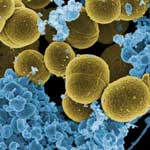 Life-threatening infectious diseases caused by antibiotic-resistant pathogens have been of great concern in both community and hospital settings. This increasing emergence of antibiotic-resistant strains of pathogens has necessitated the development of new antimicrobial surfaces and coatings. As antimicrobial surfaces have become popular in such areas as consumer products, public spaces such as schools and offices, and public transportation, the market for these coatings has quickly grown into a market worth hundreds of million of dollars. New work, by a team from Rensselaer Polytechnic Institute (RPI) has now combined the antimicrobial property of a cell lytic enzyme (lysostaphin) and the excellent properties of carbon nanotubes as an immobilization support in preparing nanocomposite paints that are highly effective against antibiotic-resistant strains of Staphylococcus aureus - methicillin-resistant Staphylococcus aureus (MRSA).
Life-threatening infectious diseases caused by antibiotic-resistant pathogens have been of great concern in both community and hospital settings. This increasing emergence of antibiotic-resistant strains of pathogens has necessitated the development of new antimicrobial surfaces and coatings. As antimicrobial surfaces have become popular in such areas as consumer products, public spaces such as schools and offices, and public transportation, the market for these coatings has quickly grown into a market worth hundreds of million of dollars. New work, by a team from Rensselaer Polytechnic Institute (RPI) has now combined the antimicrobial property of a cell lytic enzyme (lysostaphin) and the excellent properties of carbon nanotubes as an immobilization support in preparing nanocomposite paints that are highly effective against antibiotic-resistant strains of Staphylococcus aureus - methicillin-resistant Staphylococcus aureus (MRSA).
Jul 12th, 2010
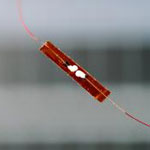 Biomechanical energy is one of the main energy components in biological systems. Developing an effective technique that can convert biomechanical energy into electricity is important for the future of in vivo implantable biosensors and other nanomedical devices. Researchers have already shown the conversion of biomechanical energy into electricity by a muscle-movement-driven nanogenerator to harvest mechanical energy from body movement under in vitro conditions. In a first demonstration of using nanotechnology to convert tiny physical motion into electricity in an in vivo environment, the same team has now reported the implanting of a nanogenerator in a live rat to harvest energy generated by its breath and heartbeat.
Biomechanical energy is one of the main energy components in biological systems. Developing an effective technique that can convert biomechanical energy into electricity is important for the future of in vivo implantable biosensors and other nanomedical devices. Researchers have already shown the conversion of biomechanical energy into electricity by a muscle-movement-driven nanogenerator to harvest mechanical energy from body movement under in vitro conditions. In a first demonstration of using nanotechnology to convert tiny physical motion into electricity in an in vivo environment, the same team has now reported the implanting of a nanogenerator in a live rat to harvest energy generated by its breath and heartbeat.
Jul 9th, 2010
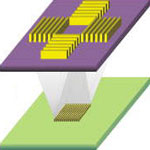 After achieving the 45-nm process, today's semiconductor industry is nearing the 20-nm process and looking for techniques that would enable sub-22-nm-half-pitch line patterns. Following the continuous increase in exposure tool numerical aperture, researchers are pursuing reductions in exposure wavelengths. This effort had them look at extreme ultraviolet (EUV: 13.4 nm in wavelength) as an exposure light source. Unlike the numerical aperture engineering, change of a light source to EUV demands development of its related components, such as photoresist and optics. Until a reliable solution for EUV lithography is developed, EUV interference lithography (EUVIL) would not solely advance the lithographic technology but would also help to optimize photoresist materials for EUV.
After achieving the 45-nm process, today's semiconductor industry is nearing the 20-nm process and looking for techniques that would enable sub-22-nm-half-pitch line patterns. Following the continuous increase in exposure tool numerical aperture, researchers are pursuing reductions in exposure wavelengths. This effort had them look at extreme ultraviolet (EUV: 13.4 nm in wavelength) as an exposure light source. Unlike the numerical aperture engineering, change of a light source to EUV demands development of its related components, such as photoresist and optics. Until a reliable solution for EUV lithography is developed, EUV interference lithography (EUVIL) would not solely advance the lithographic technology but would also help to optimize photoresist materials for EUV.
Jul 8th, 2010
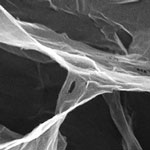 Given the massive interest and rapid developments in graphene research, scientists are now convinced that the controlled preparation of graphene-based materials with hierarchical and well-defined structures will pave the way for achieving high-performance applications of graphene in various technological fields such as optoelectronics, energy storage, polymer composites and catalysis. Self-assembly techniques have become some of the most effective strategies for this purpose. Although 2D self-assembly of graphene has been studied extensively from the perspectives of fundamental research and commercial applications, 3D self-assembly of 2D nanoscale graphene into functional macrostructures with well-defined networks remains as a great challenge and represents an important hurdle towards practical applications. Researchers in China have now provided a solution to this problem by demonstrating the successful preparation of self-assembled graphene hydrogel via a one-step hydrothermal process.
Given the massive interest and rapid developments in graphene research, scientists are now convinced that the controlled preparation of graphene-based materials with hierarchical and well-defined structures will pave the way for achieving high-performance applications of graphene in various technological fields such as optoelectronics, energy storage, polymer composites and catalysis. Self-assembly techniques have become some of the most effective strategies for this purpose. Although 2D self-assembly of graphene has been studied extensively from the perspectives of fundamental research and commercial applications, 3D self-assembly of 2D nanoscale graphene into functional macrostructures with well-defined networks remains as a great challenge and represents an important hurdle towards practical applications. Researchers in China have now provided a solution to this problem by demonstrating the successful preparation of self-assembled graphene hydrogel via a one-step hydrothermal process.
Jul 7th, 2010
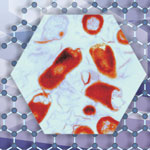 Researchers have made the surprising finding that graphene-based nanomaterials possess excellent antibacterial properties. Although antibacterial materials are widely used in daily life, and the antibacterial properties of nanomaterials are increasingly being explored and developed as commercial products, their cytotoxicity and biocompatibility has raised questions and concerns. Chinese researchers now found that graphene derivatives - graphene oxide, graphene oxide and reduced graphene oxide - can effectively inhibit bacterial growth. This is a significant finding as previous have proven that graphene, particularly graphene oxide, is biocompatible and cells can grow well on graphene substrates. Furthermore, while silver and silver nanoparticles have been well know to be antibacterial, they and other nanomaterials are often cytotoxic.
Researchers have made the surprising finding that graphene-based nanomaterials possess excellent antibacterial properties. Although antibacterial materials are widely used in daily life, and the antibacterial properties of nanomaterials are increasingly being explored and developed as commercial products, their cytotoxicity and biocompatibility has raised questions and concerns. Chinese researchers now found that graphene derivatives - graphene oxide, graphene oxide and reduced graphene oxide - can effectively inhibit bacterial growth. This is a significant finding as previous have proven that graphene, particularly graphene oxide, is biocompatible and cells can grow well on graphene substrates. Furthermore, while silver and silver nanoparticles have been well know to be antibacterial, they and other nanomaterials are often cytotoxic.
Jul 5th, 2010
 Glass fibers are a widely used reinforcing agent for many materials, from polymers to concrete. The most prominent glass fiber composite is fiberglass, a glass-reinforced plastic. The performance of the glass fiber composite over time depends on the durability of the polymer matrix and the fiber fracture behavior of the material. Since a conventional glass fiber is electrically insulating, traditionally, the monitoring for composite damage has been conducted by external sensors - a technique that degrades the mechanical properties of the material's structure and increases the cost. Researchers have therefore been working on the development of electrically conductive glass fiber plastics by adding conductive particles such as carbon blacks and carbon nanotubes to a polymer matrix. Researchers have now demonstrated a simple approach to deposit carbon nanotube networks onto glass fiber surfaces, thereby achieving semiconductive MWCNT-glass fibers.
Glass fibers are a widely used reinforcing agent for many materials, from polymers to concrete. The most prominent glass fiber composite is fiberglass, a glass-reinforced plastic. The performance of the glass fiber composite over time depends on the durability of the polymer matrix and the fiber fracture behavior of the material. Since a conventional glass fiber is electrically insulating, traditionally, the monitoring for composite damage has been conducted by external sensors - a technique that degrades the mechanical properties of the material's structure and increases the cost. Researchers have therefore been working on the development of electrically conductive glass fiber plastics by adding conductive particles such as carbon blacks and carbon nanotubes to a polymer matrix. Researchers have now demonstrated a simple approach to deposit carbon nanotube networks onto glass fiber surfaces, thereby achieving semiconductive MWCNT-glass fibers.
Jun 30th, 2010
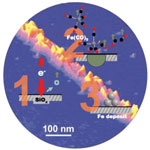 The manufacture of certain types of nanostructures - nanotubes, graphene, nanoparticles, etc. - has already entered industrial-scale mass production. However, the controlled fabrication of nanostructures with arbitrary shape and defined chemical composition is still a major challenge in nanotechnology applications. It appears that electron beams from electron microscopes (EM) - nowadays routinely focused down to the nanometer regime - are ideal candidates for versatile tools for nanotechnology. However, their usage is mostly restricted by the conditions in the corresponding electron microscopes, since most EMs are housed in high vacuum chambers the unintended electron-beam-induced deposition of residual gases is a problem, as well as the maintenance of well defined sample conditions. Researchers in Germany have now presented a novel way to use a highly focused electron beam to lithographically fabricate clean iron nanostructures. This new technique expands the application field for focused electron beams in nanotechnology.
The manufacture of certain types of nanostructures - nanotubes, graphene, nanoparticles, etc. - has already entered industrial-scale mass production. However, the controlled fabrication of nanostructures with arbitrary shape and defined chemical composition is still a major challenge in nanotechnology applications. It appears that electron beams from electron microscopes (EM) - nowadays routinely focused down to the nanometer regime - are ideal candidates for versatile tools for nanotechnology. However, their usage is mostly restricted by the conditions in the corresponding electron microscopes, since most EMs are housed in high vacuum chambers the unintended electron-beam-induced deposition of residual gases is a problem, as well as the maintenance of well defined sample conditions. Researchers in Germany have now presented a novel way to use a highly focused electron beam to lithographically fabricate clean iron nanostructures. This new technique expands the application field for focused electron beams in nanotechnology.
Jun 28th, 2010
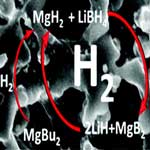 The main obstacle to building a hydrogen economy is the lack of efficient hydrogen storage. The research conducted in the hydrogen storage scientific community is aimed towards mobile applications. Hydrogen is a gas at ambient conditions and takes up a lot of space. For stationary storage facilities, for which available space is not an issue, hydrogen gas can be kept in large tanks at moderate pressures using already known technology. However, in order to utilize hydrogen for mobile applications i.e. to produce and be able to sell hydrogen fueled cars on a large scale, it must be stored in a compact, safe, cheap and efficient way. A European research team has now reported on a new concept for hydrogen storage using nanoconfined reversible chemical reactions. They demonstrate that nanoconfined hydride has a significant hydrogen storage potential.
The main obstacle to building a hydrogen economy is the lack of efficient hydrogen storage. The research conducted in the hydrogen storage scientific community is aimed towards mobile applications. Hydrogen is a gas at ambient conditions and takes up a lot of space. For stationary storage facilities, for which available space is not an issue, hydrogen gas can be kept in large tanks at moderate pressures using already known technology. However, in order to utilize hydrogen for mobile applications i.e. to produce and be able to sell hydrogen fueled cars on a large scale, it must be stored in a compact, safe, cheap and efficient way. A European research team has now reported on a new concept for hydrogen storage using nanoconfined reversible chemical reactions. They demonstrate that nanoconfined hydride has a significant hydrogen storage potential.
Jun 24th, 2010
 Life-threatening infectious diseases caused by antibiotic-resistant pathogens have been of great concern in both community and hospital settings. This increasing emergence of antibiotic-resistant strains of pathogens has necessitated the development of new antimicrobial surfaces and coatings. As antimicrobial surfaces have become popular in such areas as consumer products, public spaces such as schools and offices, and public transportation, the market for these coatings has quickly grown into a market worth hundreds of million of dollars. New work, by a team from Rensselaer Polytechnic Institute (RPI) has now combined the antimicrobial property of a cell lytic enzyme (lysostaphin) and the excellent properties of carbon nanotubes as an immobilization support in preparing nanocomposite paints that are highly effective against antibiotic-resistant strains of Staphylococcus aureus - methicillin-resistant Staphylococcus aureus (MRSA).
Life-threatening infectious diseases caused by antibiotic-resistant pathogens have been of great concern in both community and hospital settings. This increasing emergence of antibiotic-resistant strains of pathogens has necessitated the development of new antimicrobial surfaces and coatings. As antimicrobial surfaces have become popular in such areas as consumer products, public spaces such as schools and offices, and public transportation, the market for these coatings has quickly grown into a market worth hundreds of million of dollars. New work, by a team from Rensselaer Polytechnic Institute (RPI) has now combined the antimicrobial property of a cell lytic enzyme (lysostaphin) and the excellent properties of carbon nanotubes as an immobilization support in preparing nanocomposite paints that are highly effective against antibiotic-resistant strains of Staphylococcus aureus - methicillin-resistant Staphylococcus aureus (MRSA).
 Subscribe to our Nanotechnology Spotlight feed
Subscribe to our Nanotechnology Spotlight feed





